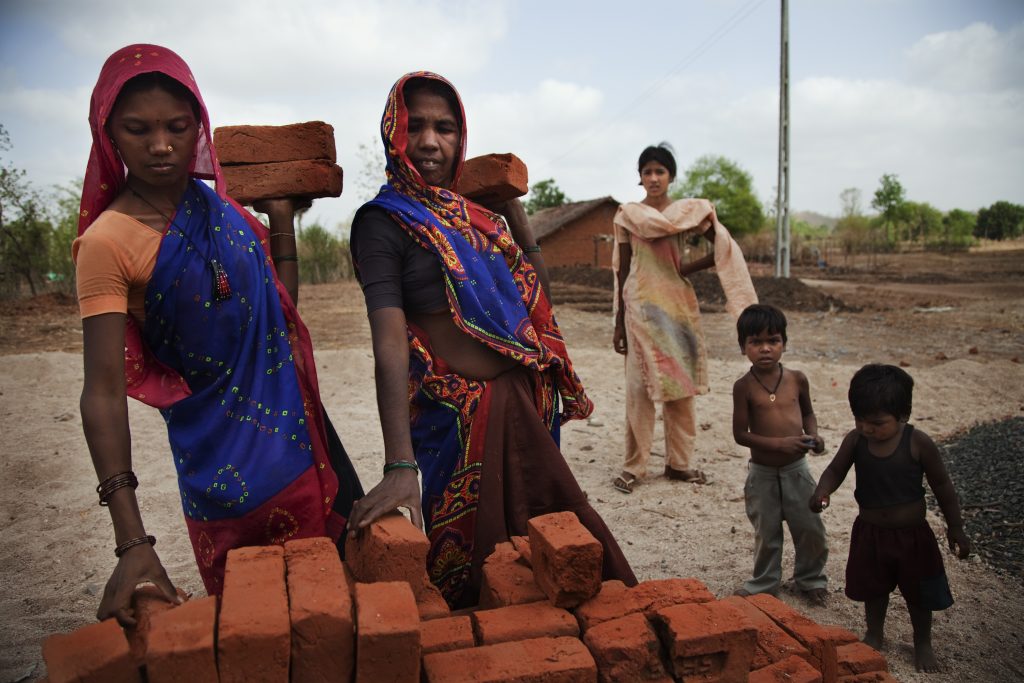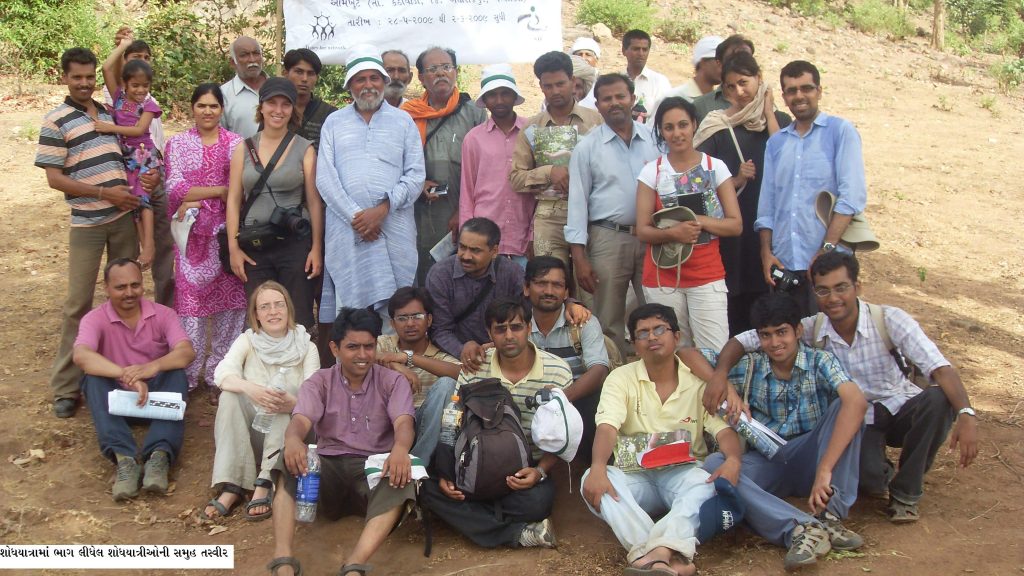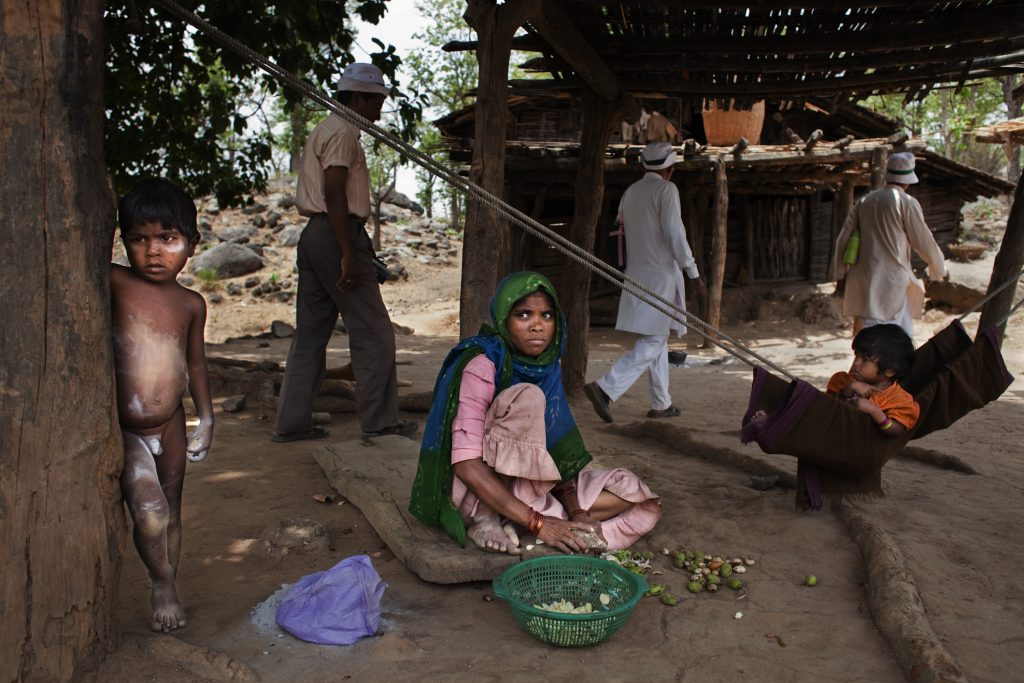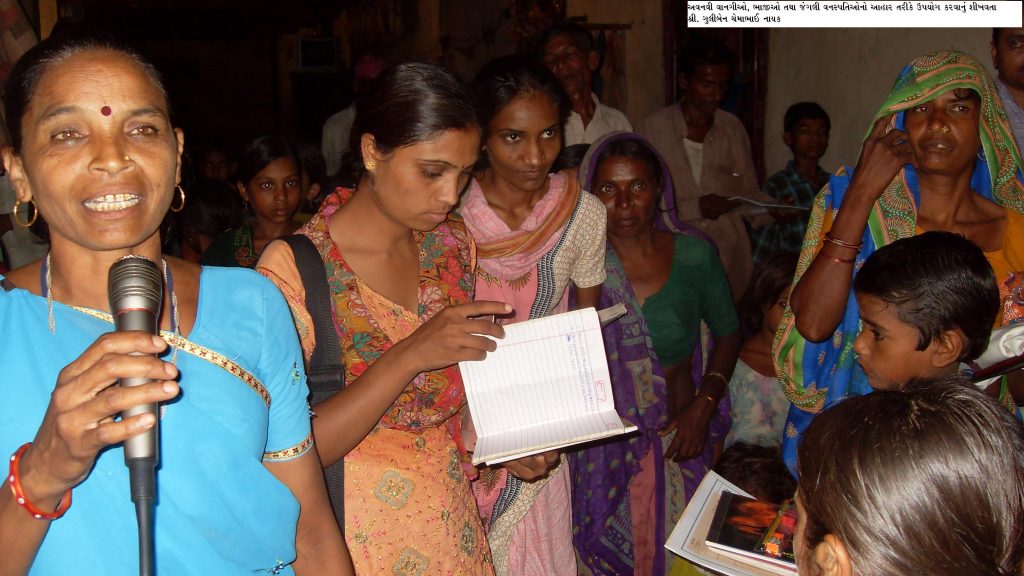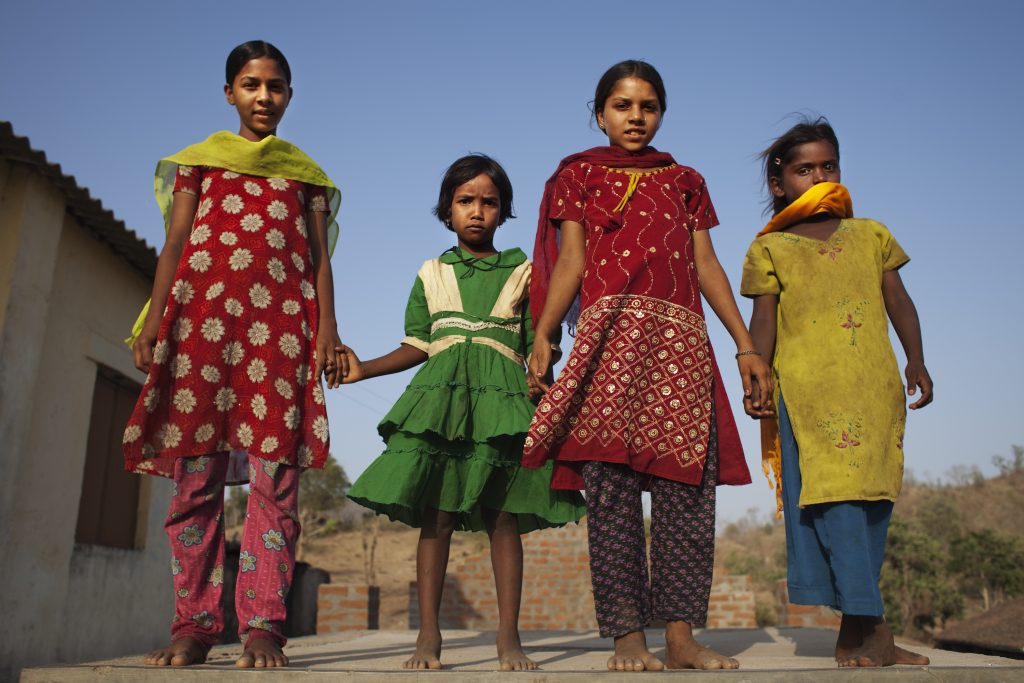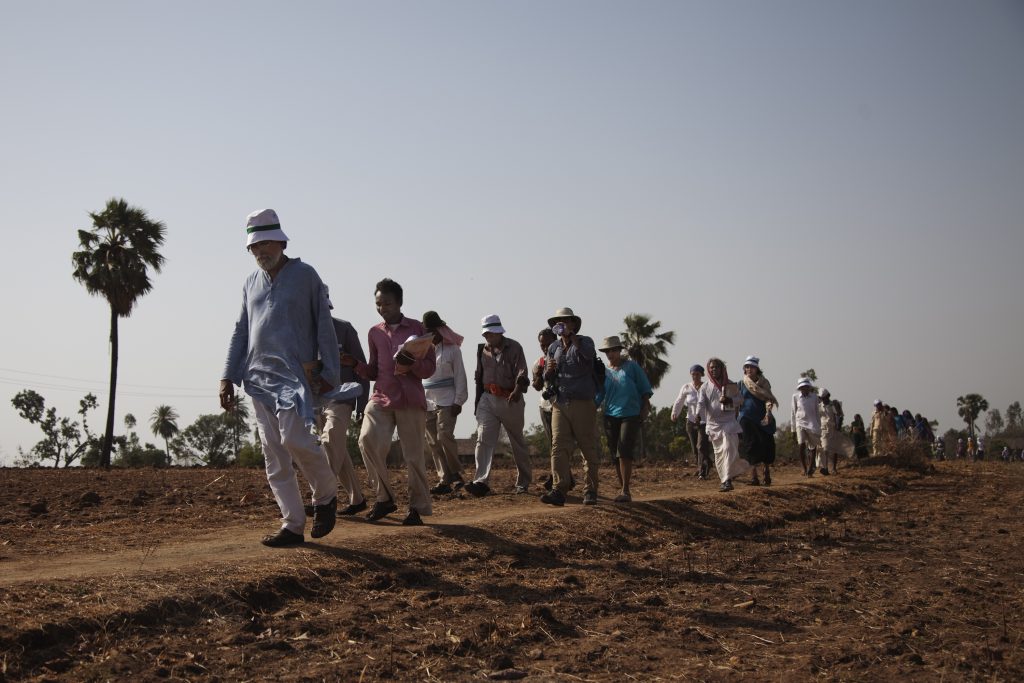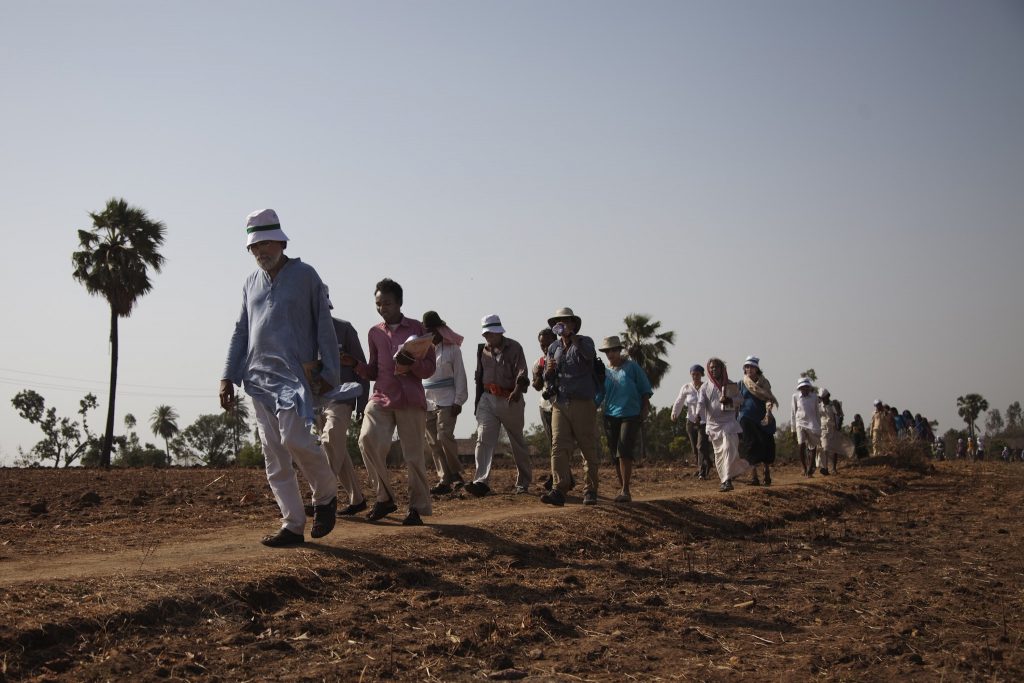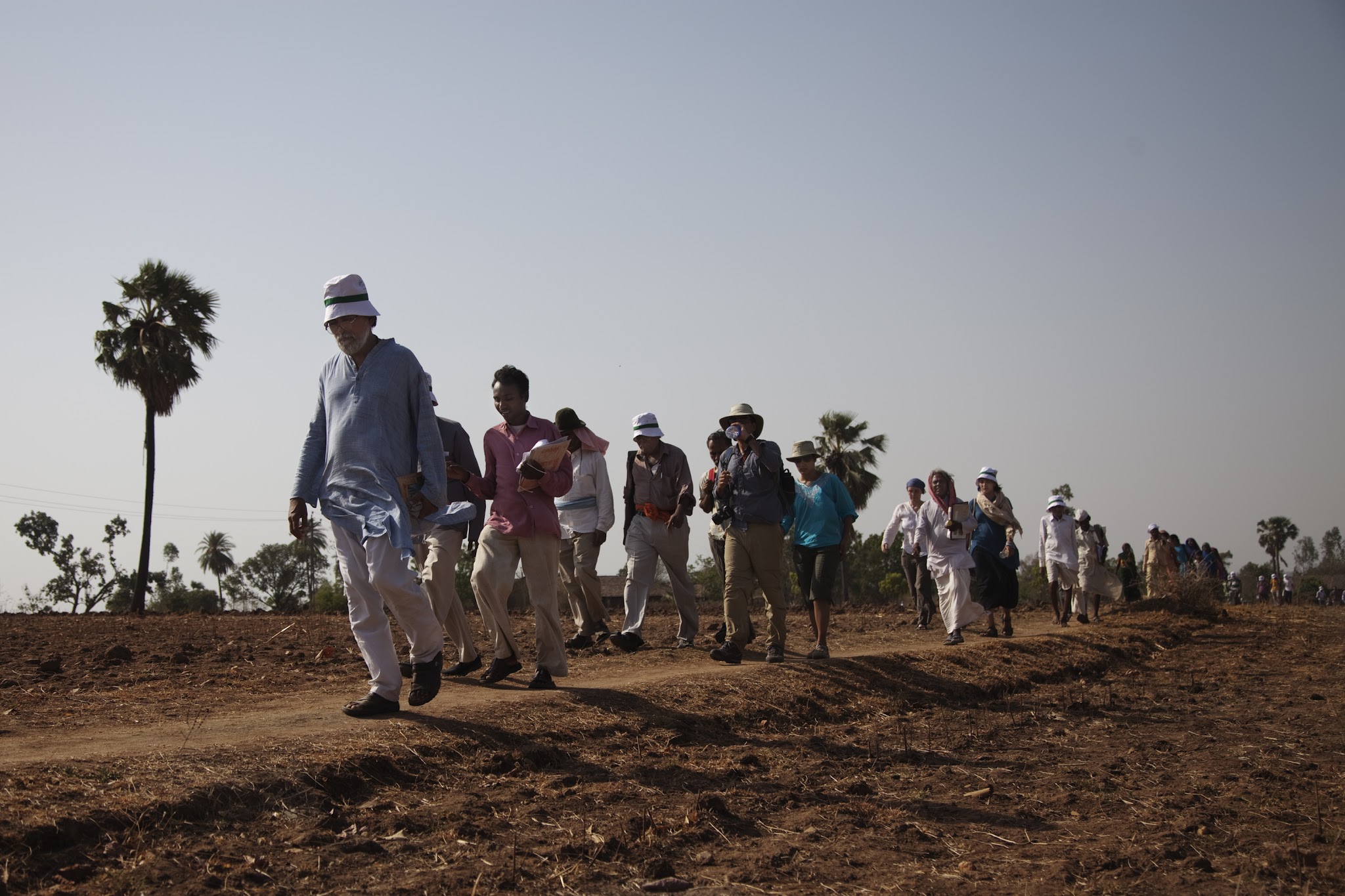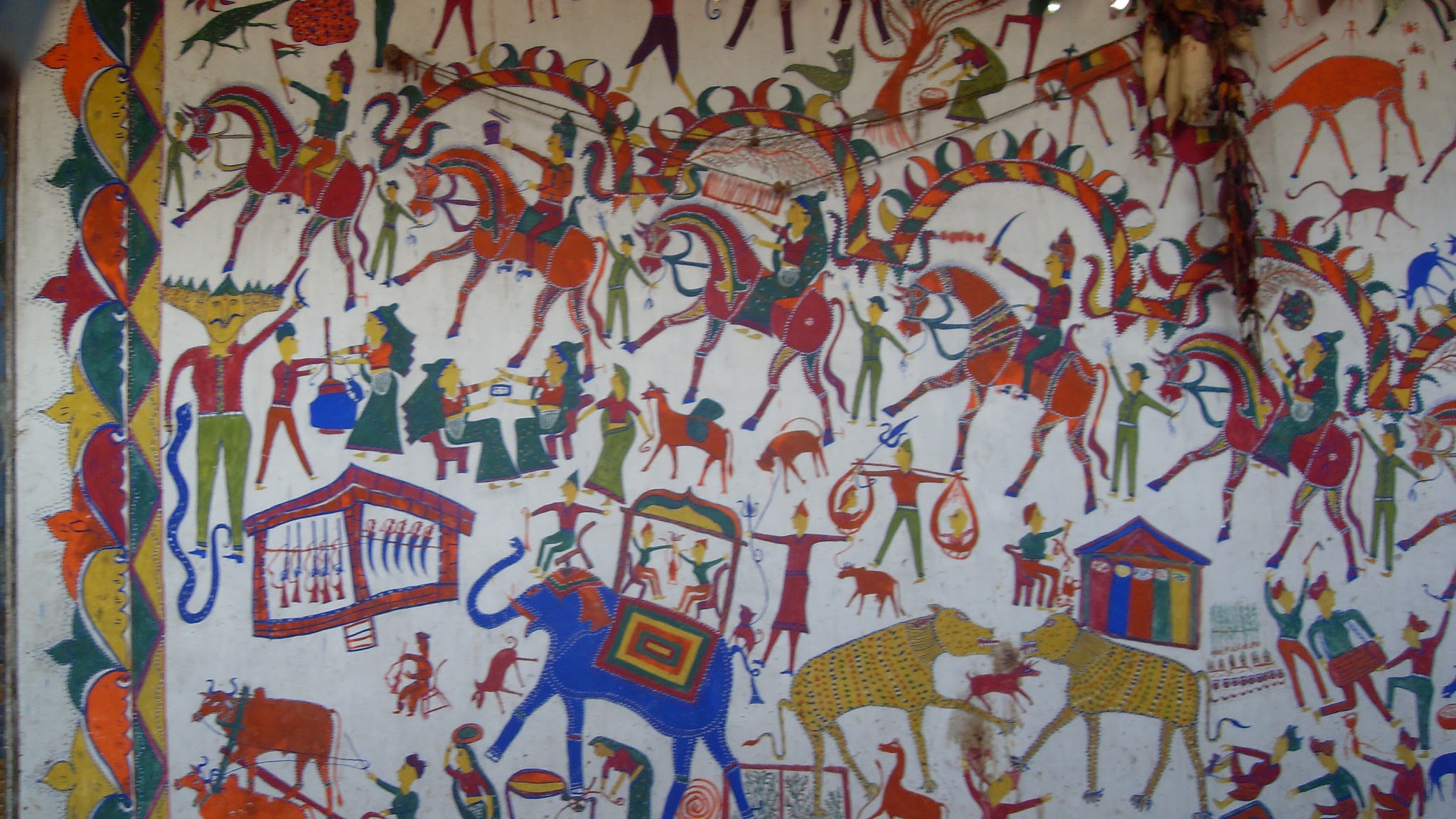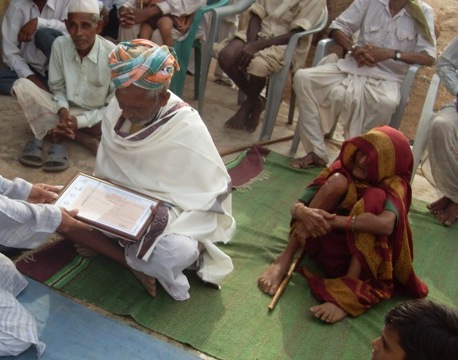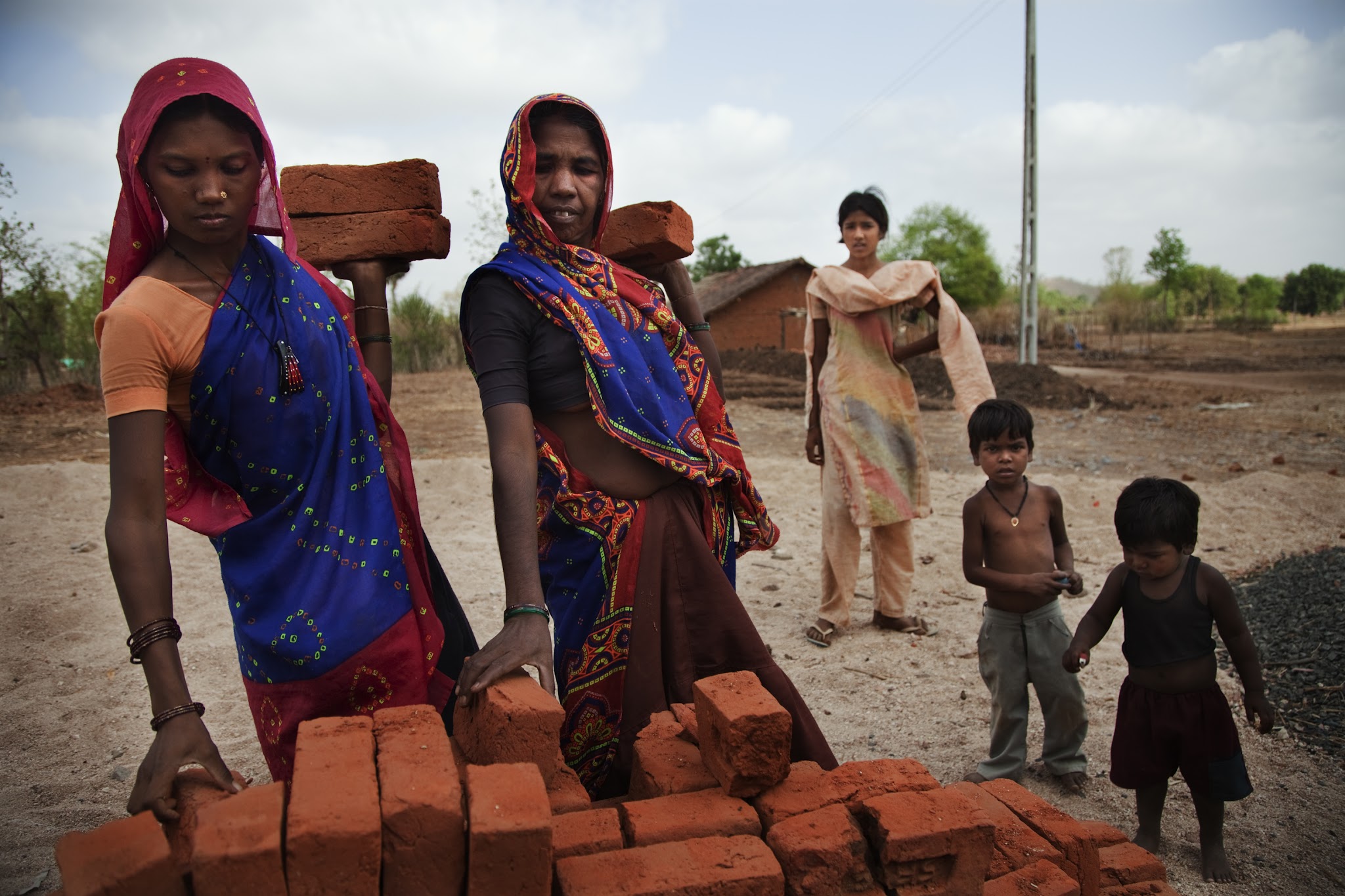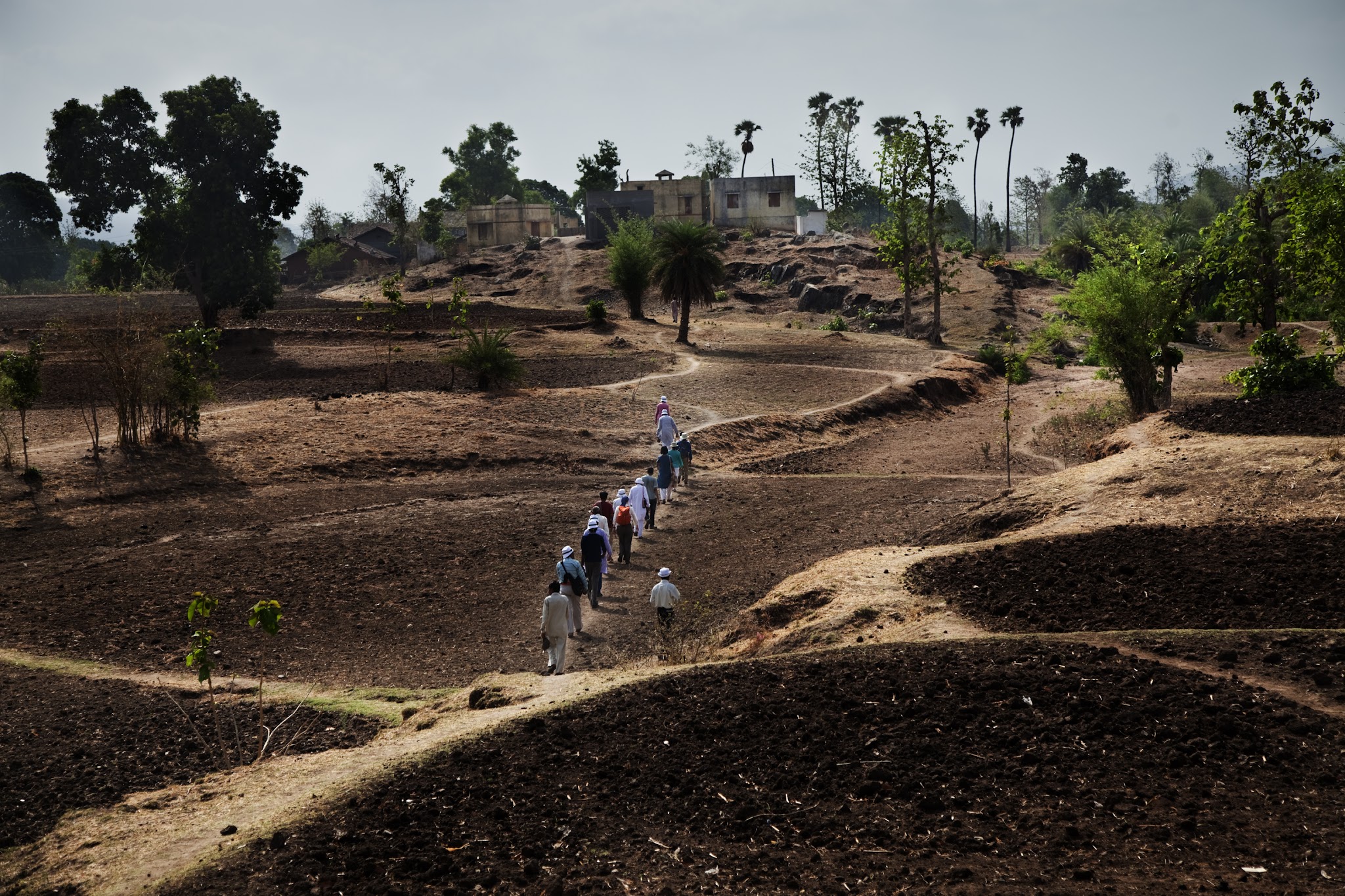Get Next Shodhyatra Update:
Phone:
079-27913293, 27912792
Email:
shodhyatra@sristi.org
23RD SHODHYATRA - FANGIA (GUJARAT) TO AAMKHUNT (MADHYA PRADESH)
SANCTUARY OF SILENCE : WITNESSING DEATH OF CURIOSITY WHEN A PROBLEM GETS SOLVED
Tatya Tope, the revered freedom fighter, is believed to have spent the last few days of his life in Dahod region. Being located between the states of Gujarat and Malwa, the latter being further divided into Madhya Pradesh and Rajasthan; that’s how the region got its name as Dahod (‘do’ meaning ‘two’ and ‘had’ meaning ‘border’). The eminent Gujarat poet Nanalal characterized Dahod as the ‘Easter gateway of Gujarat’. We walked through Ratanamahal Sloth Bear Sanctuary where trees like mahudo (Madhuca indica J. f. Gmel), timru (Diospyros melanoxylon Roxb.) and sadad (Terminalia crenulata Roth) feed the sloth bear and provide income to local communities. Wheat and maize are the major crops of the region. The learning walk, i.e. 23rd ShodhYatra started on 28th May 2009 from Fangia in Dahod district to Puniyavat in Alirajpur district (earlier, part of Jhabua district), Madhya Pradesh, crossing 165 km of distance, discovering newer means of survival without impairing sustainability, though in a few cases, imminent threats were visible.
Shri Nayak Vanbandhu Uttar Buniyadi Ashram Shala in Fangia, from where the Yatra started, provides free education to tribal children. Before its establishement in 2005 by Daharbhai and Mohanbhai Nayak, children had to walk 13-14 km daily to attend school. Twelve herbal healers from nearby villages shared their experience in dealing with human and animal ailments, improving crop production and conserving environment. It was very instructive to learn once again that same plant was often used for multiple purposes just as same disease or problem was solved through multiple plants or their combinations. Significant variations at short distance helped us understand something unique about local knowledge. The herbal healers collectively mentioned 25 practices to cure bloat in animals using salted buttermilk, kadwa kothimda (Cucumis callosus (Rottl.) Cogn.ex Cogn. & Harms), pulp of billi (Aegle marmelos) fruit, root of renj, etc.; but none of the healers named the plant that Sakrabhai used. We wondered what prevented the dissemination of Sakrabhai’s knowledge even within an area of 15 km radius? Sakrabhai reasoned: “When members of community need my help, I willingly provide it. When a problem gets solved, their curiosity dies.” Mohanbhai, a herbal healer remarked: “All of us know traditional healing practices for different problems. If you come to me for fever, you will have to seek advice of others for diarrhoea, limb dislocation, sprain, etc.” He said that rogat rohida (Tecomela undulata D. Don) was useful to cure bruises, bloat and other stomach related ailments in animals. Even an iron nail poked in its bark would melt pointing to its strength. We could find only Budhliben of Jamran who knew the use of this plant to cure bruises. On being asked how she knew it, she puzzled us with a rhetorical question: “Can we be called vanvasis (inhabitants of forest) if we do not know about the biodiversity of forest region?” She also knew that amravel (Cuscuta chinensis Lam.) can be used to cure a disease in poultry birds called ‘marki’. This practice is prevalent in Gujarat but not in Madhya Pradesh. Kalanbhai Nayak, an expert in curing jaundice, goes as far as Alirajpur to attend calls because even if others know about a cure, only his word is considered authoritative. Sometimes traditional healers pool their knowledge to solve a problem which none of them could have individually solved. When Kanglabhai was struck by a bear and seriously injured, he was cured by the collaborative effort of healers Kalanbhai, Manabhai and Bhavabhai. Lateral learning, the genesis of Honey Bee Network was thus clearly visible in the way they led their life. Yatris took a short halt at Manabhai’s home where he applied a herbal cream on everyone’s forehead. It gave a strong sensation, but was reported by him to be extremely helpful during cough and headache. A Self Help Group which makes vermicompost manure was visited next. It sells manure in Chhotaudepur, Devgadh Baria and Dhanpur. They found marketing their produce in different, far off places was a challenge for them, and it also increased their costs.
Here, women who make ‘padiyas’ (bowls) out of timru (Diospyros melanoxylon Roxb) leaves have resolved not to cut the boughs of any tree. By way of small innovations, they have made their devices capable of cutting only the far off twigs having fresh leaves. This way both, twigs and fruits grow faster. These women thus made a profound point in sustainable consumption to the yatris. Manabhai was felicitated in a wedding ceremony that he was attending at Jamran.
Thereafter, while walking through the village, yatris observed how local tribal communities built homes using locally made tiles, which are flatter; and in most villages, there are no moulds. While digging earth, only the soil from the lower layers which is finer, has less granules and gives less cracks, is taken (unlike the brick industry which takes away the top soil) for making tiles and for different wall designs.
This is a very sustainable practice since the top layer has the most nutrients and that is not damaged during this process.
In the entire village, Makkabhai was the only farmer who grew kodri (finger millet: Eleusine corcona) crop. A villager Somabhai Baria said that if kodri tastes bitter, it leads to toxic symptoms (when one sees different kind of colours, loses control a bit, has some kind of hallucination). However, consuming curd and jaggery helps in reversing the toxic symptoms. It is a good grain for sick or convalescing people, has high fibre and nutritional content and can be stored safely for 100 years. Yet, both Makkabhai and Somabhai did not know what centenarian Nanabhai of Dungarpur shared with us later during the yatra that if kodri seeds pop on being heated, they are edible and if they get burnt, they are toxic. Another example where knowledge had not crossed a distance of even 12 km before Honey Bee Network reached the place! Rebuilding horizontal flow of communication even in tribal communities (not to speak of urbanized societies) seemed a serious challenge facing the social institution builders.
Somabhai and Udaliben Bariya; and their daughter Savita knew that kodri can be used for curing certain skin diseases as well. Yatris were deeply impressed by the knowledge of the young girl Savita, who listed 62 plant names and their uses. We also saw bunches of different sizes and varieties of maize (Zea mays L.) hanging in a house. It was learned that this makes it easy to identify the type of maize while sowing. Moreover, it prevents rotting, stored grain pests, moisture due to regular exposure to smoke of cooking hearth.
Next day, while going to Ruparel, yatris saw tribal women, each carrying as many as eight bricks on her head. It was painful and yatris wondered, why has this problem remained unsolved? Why could not there be an easier way of performing this task reducing the drudgery of construction workers? In Ruparel, Jamku and Sanjay won the biodiversity competition. High level of energy among the children in the village meeting was evident when they recited in chorus, a famous Gujarati folk poem: ‘Naani maari aankh, e to joti kaank kaank, e to kevi ajab jevi vaat che!” (My two little eyes watch the world with wonder; how wonderful is that!)
In Paanchiasal, at the home of Kantiben, yatris tasted dishes made out of spinaches like ‘fang ni bhaji’ (Rivea hypocrateriformis Choisy), ‘jharakhla ni bhaji’ and rotis of maize flour made by Kantiben and Jukiben. Guliben explained that various spinach types such as ‘kali bhaji’, ‘chandela bhaji’, ‘pera bhaji’, ‘kankodi kand bhaji’, ‘dodi bhaji’ (Cucumis callosus (Rottl.) Cogn.ex Cogn. & Harms), ‘kolihar bhaji’, and others increase energy levels, augment resistance, and regulate body heat in intense summer. The three women were invited to set up their stalls in Satvik 2010 (the traditional Food Festival) to infuse entrepreneurial spirit among other local tribal communities. ShodhYatris learnt from women about various types of kands (tubers/rhizomes) growing in forests such as ‘jangli suran’ (Amorphophallus commutatus (Schott.) Engler.),‘varahikand’ (Dioscorea bulbifera L.), ‘surikand’, ‘jangli aadu’ (Zingiber cernuum Dalz.), ‘terakand’, ‘sherakand’ and others which were reported to be edible after some treatment to dissolve and remove the toxic element in them. ‘Dudh golia kand’ reportedly increases lactation in mothers and ‘vajakand’ (Acorus calamus L.) improves metabolism. In times of drought, people survive on these tubers. Villagers were encouraged to form horizontal markets for the exchange and dissemination of such traditional knowledge. If only planners realize the importance of such biodiversity in generating livelihood for the knowledge rich, economically poor people, instead of asking them to dig earth or break stones under various employment programmes.
LIVING TRADITIONS
The ShodhYatris then marched towards Sevaniya village. Here, a 700 years old step well (vav), built by king Gadesingh was seen. Even during the distressing drought known as ‘chappaniya dushkaal’, this vav had enough fresh water for sustenance of 10 to 12 nearby villages. Till date, villagers use water of this step well for drinking. While crossing Japatiya village, yatris saw a painted wall (locally known as ‘pithoro’) depicting folktales, traditional and modern motifs and a commentary on social evils such as beating wives. On inquiring, we learnt that Kanubhai Kagubhai had got it done by Babubhai, an artist from Gojiya after his particular wish was fulfilled.
Why did Kanubhai, who hardly had any belongings in his house have the wall painted? May be his way of fulfillment made his own life colourful and also provided employment to an artist. This shows that the aesthetic sense of people on the edge of survival sometimes helps them sail through harsh economic and social conditions. It also provides a proof, if a proof is indeed needed, that Maslowian model of hierarchy of needs is completely unsuitable for our culture.
KNOWLEDGE, CULTURE, ENTERPRISE
In the entire walk of about 100 km, yatris came across only one more such household just at the base of Ratanmahal sanctuary where similar paintings were seen, though with lower quality of detail. This is in sharp contradiction to the motives of the National Rural Employment Guarantee Scheme according to which the only work that Babubhai and the likes can do is breaking stones and digging earth. While there may not be any public policy at the state or central level to conserve such arts and artistic traditions, local communities are trying to do their bit as long as they can (see Creative Culture at Grassroots, http://www.sristi.org/cultural/). Here, ShodhYatris also saw local people making various
utility items out of leaves of date palm (Phoenix dactylifera L.). Chaganbhai dexterously made pans, ropes, buckets and other objects from the bark of netar (Calamus rotang L.). We wondered, could not demand for these products provide a better employment opportunity for them than just menial work?
At Sadara, in Kagubhai Baria’s house, we saw an engine of 14 hp performing three different functions simultaneously, viz. drawing water out of a well, grinding food grains and extracting oil out of mahuda (Madhuca indica J. f. Gmel.) fruits. Walking towards the Tokarwa village, yatris came across some painful situations, where the availability of drinking water as well as its quality was not very good. Wells were being dug in many places. In one case, there were five women pulling a rope lifting the baskets full of clay, stones and mud from a well being dug by men. This is indeed the most primitive method of digging a well, continuing for the last 2000 years. After a while, we met Khumansinh who had designed a horizontal pulley-based system for lifting clay and stones from a well, costing hardly 1500 rupees. When the basket came up after the rope was pulled, he would move the entire lifting arrangement sideways, so that it could be emptied easily. After another few kilometres, yatris found of course a motorized well-digging system costing more than Rs. 50,000. So, from completely primitive to semi-mechanical to completely motorized, one could see three different time zones of technology in such a short stretch of land.
Khumansinh, a Kabirpanthi, fondly called Khemdas by villagers wanted to design a windmill to run a ceiling fan in his home. There have been many experiments about the windmill around the world, but this was the first time one heard someone planning to use a windmill to run a ceiling fan. This innovative idea may be supported by Honey Bee Network. He also had a simple distillation system for making herbal extracts for providing medicine to the neighbouring farmers.
In context of the most unfortunate hooch tragedy, yatris discussed what if tribal people who make liquor can be enabled to distill and sell herbal and spice extracts? Will it not be worthwhile to divert the distillation skills of local people towards more value addition and income-generating alternatives instead of liquor?
The night was spent at the home of Ishwarbhai, who has been associated with SRISTI since 1997, yatris enjoyed the simple yet nutritious dinner of vadas made out of black gram, kadhi made out of tamarind leaves, roti, sabji, dal and rice. In Dungarpur, Khumansinh suggested that after ponds in the village dry up, their basin land can be given to landless villagers for raising atleast one crop. In a village meeting, the demise of a knowledgeable person was compared to the end of a library.
It was discussed that in the era of learning by way of education, knowledge cannot be spread verbally; hence documentation is necessary. Here, centenarian couple Shantaben and Nanabhai Dalsinghbhai Dharwa was felicitated. Both Nanabhai and his son are herbal healers and handle patients together. Bhavsin Rathwa, a carpenter and blacksmith, who had makes instruments for carving on wood, was also felicitated. Here Sanjili and Vinay, a student couple from MIT, Boston gave their XO’s ($ 100 laptop) to children to play with. Sanjay while playing with it, switched on the webcam and started clicking pictures of crows, buffaloes, birds and goats. Perhaps he wanted to see how they look on screen.
On the way from Dungarpur towards Nansalai, we saw that clay horses of different sizes were kept under a sacred tree. When a cow or buffalo gives birth to a young one, before consuming its milk, the tribal offer this clay horse to forest deity as a token of gratitude. It was further learned that mahuda flowers, if roasted and eaten, can stimulate appetite. Even the oil of its fruit is useful in cooking. A blank Village Knowledge Register was given to the Sarpanch of Nansalai village to inspire local people to document traditional knowledge. Here Lachiben Dharwa mentioned that a bowl made out of ‘kansa’ (also called as bell metal) helped her remain healthy (maybe because it was a mixture of copper (proportion more than half) and tin, and sometimes iron; zinc, and mineral stannite). While walking towards Mendri village, yatris discussed about the judicious consumption of date fruit by tribal. It seemed that during slack season in farming, the work in cities like Surat and Baroda as construction labourers. Before leaving, they store date fruits. When they return to their abode, they face an acute shortage of food and survived on the dried date fruits.
While traversing through the Ratanmahal sanctuary, yatris could see a canopy of old trees, but no new trees were found to be planted. A bird, locally called ‘titori’ caught the attention of the yatris who were told that the height of the place at which the bird nested denoted, how much it would rain that particular year. In Pipariya, a few herbal healers participated in the meeting but were reluctant to disclose their knowledge. Sakrabhai exhorted them to disclose their knowledge by giving his own example of how he was helped to disseminate his knowledge through Honey Bee Network. When he was slightly injured during the course of the yatra, the two French journalists Gesa and Alice, as well as Sanjili and Vinay took utmost care of him just like an elder family member. On the way, the yatris also saw bamboo huts built on stilts for protection from wild animals. Here ‘kadaknath’ hens, a rare species found only on the Gujarat- Madhya Pradesh border were seen. It is famous for its shining black feathers. On the way to the Uma Uchhtar Madhyamik School, Kanjeta, yatris met Maheshbhai Prajapati, a potter who had attached a cycle’s rim, spoke and axle to the traditional potter’s wheel. During the cold night, ShodhYatris reflected on the day and also shared their experiences. Few volunteers engaged the children in creative games and painting competitions for which prizes were also distributed to them. The reflections done in the night was not the culmination point. Next morning, Yatris after crossing hilly terrain, reached Alindra.
CYCLE RIM, SPOKE AND AXLE ATTACHED TO POTTER'S WHEEL: MAHESH PRAJAPATI, KANJETA
Children involved in creative model building on environment issues, Kathiwada
Most important discoveries in life are made in journeys in which walking together is more important than reaching the destination.
The destination of a physical journey may be known but where would one’s inner journey take oneself is often not known in advance. Did we know that we would meet Manishaben who though outcasted by her own family, fought her exclusion through several creative achievements in a tribal region. Read further….
LEARNING FROM NATURE
While crossing the hilly terrains to reach Alindra, yatris were awestruck to find a flock of pelicans amidst rocks around a tree grove. Khanpariyabhai, one of the Shodh yatris, explained: “If ever you are lost in a forest and feel thirsty, spotting a pelican will indicate a pond or a stream nearby.”
On the way to Jetpur, yatris saw three feet tall termite soil mounds. A discussion took place about termites as eco-indicators. A termite soil mound may also sometimes be an indicator of a ground water source.
Ants taking their eggs to a higher point around termite mounds or trees indicate impending rains. Complexity of climate is unlocked through such indicators, a subject needing much more thorough study in the wake of global climate changes looming large on the horizon.
When we asked Jasubhai Bhuria, a prominent human healer in Bhuvero, about a cure for an important local diseases, he said, “By God’s grace, we are residents of forest areas, hence we do not fall ill. Even if we do, we know that the biodiversity around us will cure us.” To say this is easy but for the people having such faith, it is a credo for everyday life.
CARING FOR THE "OTHER": LESSONS IN INCLUSIVENESS
In Alindra, Rangalabhai Bhuriya, a herbal healer used jal jambu (Alternanthera sessilis (L.) R. Br. ex DC.) to treat fever (a practice found in parts of Africa also: Eds.). Other villagers knew about the practice but did not use it. Jasubhai Bhuria described the use of a syrup of jamun (Syzygium cumini (L.) Skeels) in diabetes.
In this context, the real learning was not about just the knowledge of these herbal healers. It was the magnanimity of their spirit and their concern for general well being. When asked about the issue of sharing knowledge with us, the people invariably said, “Will you not take our knowledge to other villagers? Will it not help them?
Do we care at all about the rest?”
This is the kind of respect, we would call it the respect for the “other”, that the otherwise uneducated villagers showed which even the chin stroking academicians and self proclaimed guardians of society would often find hard to emulate.
When the yatris descended from Ratanmahal Sanctuary into Madhya Pradesh, they were all very tired and thirsty. Despite scarcity of water in the region, women living at the foothill fetched water and offered it to the yatris. When some of the yatris offered to replenish it, they were affectionately scolded for even suggesting that. Such is the spirit of non-reciprocal acts.
FIGHTING EXCLUSION CREATIVELY : THE CASE OF MANISHABEN
By the time yatris reached Ali Rajpur, it was already dark. Manishaben was facilitated in the night meeting at Aamkhut. She had married against the wishes of her family and was therefore outcasted by them. But her enterprising spirit induced her to grow vegetables organically on the terrace of her house and in the backyard. She would get up at five in the morning and collect cow dung from the street before sunrise, and use it to manure the bags in which she grew vegetables, including tomatoes weighing 280 gm a piece.
She had also developed an innovative formulation of a tooth
powder from the powder of dried latex of a particular plant, neem and ash. For two years, she gave it free to the villagers and thereafter decided to sell it. She claimed that her powder could cure even ulcers in mouth. Well, Manishabehn was not taught marketing and entrepreneurship in a b-school, but she had taught it herself through all the adversity in life.
CONSERVATION THROUGH OBITUARIES
Ramjibhai Charan, a young primary school teacher from Sabarkantha tries to attend as many Shodhyatras as possible. He found a very interesting approach of increasing the green cover in Gujarat. Every time, an obituary was published in newspaper,
he would write a letter to the kith and kin of the deceased, requesting them to plant a tree in the memory of their loved one. So far, he has written about 40000 such letters. The practice of small goodness is anytime better than profound thoughts but divorced from action.
FOLK TRADITIONS OF DISTINCTION
Every culture evolves stories rationalizing or mystifying its special place in the local cosmology. Yatris saw two temples while getting down from Ratan Mahal, one on Gujarat side and another in Madhya Pradesh. This land was called as kunwari bhumi [virgin land]. It is said that thousands of years ago, during a tribal war, majority of the Damor community living in Dholka region died. Lord Shiva and Goddess Parvati, it is believed, shifted the few survivors on this piece of land which had no habitation before.
As a part of ritual, people offer beautifully engraved doors or arches at the temple.
yatris saw a beautifully carved furniture at the house of Savitaben, daughter of the village chief. It was learnt that in this part of Madhya Pradesh, there was a tradition of offering furniture at the time of marriage with a caricature of couple carved on it.
THE ZEN OF EMPTYING ONESELF
The Shodhyatra ended at Puniyawat, a place near Bhabra, the birth place of the famous freedom fighter, Chandrashekar Azad. Shodh yatris reflected on the individual and collective learning during the walk. Why emptying the mind was necessary to absorb new insights was illustrated through a Zen story. A student went to a famous teacher and requested to be taught. After looking at him, the teacher asked him to come after sometime. The student went after a month requesting admission, the teacher again told him to come after sometime. Slowly and slowly, a year and a half passed without student succeeding in getting the opportunity to learn from the master. One day, he got exasperated. He asked with a sense of frustration and anger, “Respected teacher, you are teaching so many students regularly. But whenever I request attention, you ask me to come after sometime. What is my flaw, please guide me.” The teacher smiled and asked him to bring a glass of water. Then he asked him to bring another glass of water. Now came the climax. The teacher asked him to pour the water of second glass in the first one. The student said that it was not possible because the first glass was already full of water. The teacher told him, “every time you come to me, you look like a glass full of water. Unless you empty yourself, how can I offer knowledge to you”.
Another young shodh yatri told a story about how regular practice of an act formed a habit. And these habits then formed the man. Any house yatris knocked at, the question was not asked as to what they were looking for.
They were first welcomed, offered water and then discussion would begin. People were poor but rich in generosity. It is very difficult to make such a perception compatible with the normal notion about poverty of tribal people. After all, poor people were not poor in everything. Devala Ramsinh summed up the spirit rather well. He said, “come again to our village and this time for 10 – 15 days. Learn what you need and share what you know.”
Yatris reflected on their consumption pattern in the cities. Hardly ever they asked a question as to what part of their consumption basket comprised products made by tribal people. The learning from the people would resonate for many more days or months or even years. The painting on the wall, the step well functioning still after hundreds of years and a lady fighting her exclusion through creative pursuits are not purposeless. The lack of opportunities for young people to grow far in their life might breed anger sooner or later. Perhaps, society should not take them for granted. No community will remain patient indefinitely if the market and the state neglect it so much. There was a need to rethink the protocol of engagement with such culturally rich communities if development process was to become inclusive.
FLICKR GALLERY
